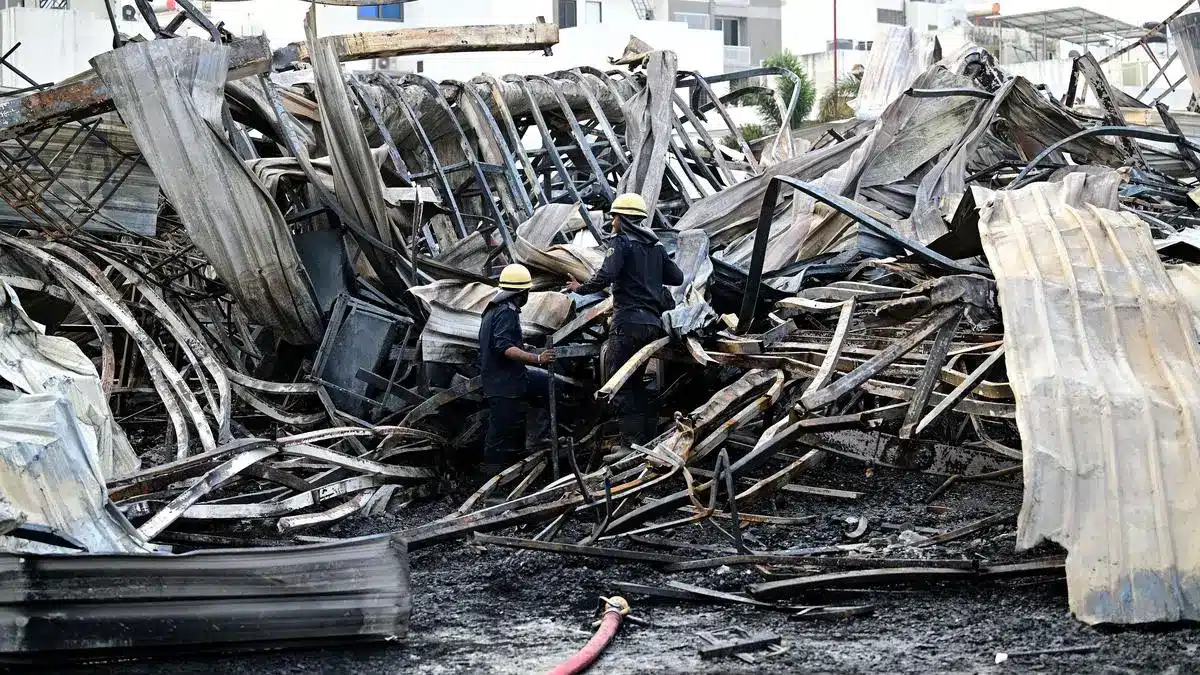What’s in today’s article?
- Background
- Fire Safety Regulations in India
- About the National Building Code
- Challenges Associated with Fire Safety in India
Background
- The recent fire tragedies at a gaming zone in Gujarat’s Rajkot and a children’s hospital in Delhi have claimed the lives of at least 40 people in a span of 24 hours.
- This has shifted the spotlight on fire safety regulations and the need for stringent enforcement of safety measures, particularly in buildings vulnerable to man-made disasters.
- According to the latest Accidental Deaths and Suicides in India (ADSI) Report, released by the National Crimes Records Bureau (NCRB), as many as 7,435 people were killed in over 7,500 fire accidents in 2022.
Fire Safety Regulations in India
- Published in 1970, the National Building Code (NBC) is India’s central standard for fire safety. It was last updated in 2016.
- It provides detailed guidelines for general construction, maintenance, and fire safety of buildings.
- State governments are required to incorporate NBC recommendations into local building bylaws, as fire services are a state subject.
- The ‘Model Building Bye Laws 2016‘ guide states and urban areas in drafting building bylaws.
- Apart from that, the National Disaster Management Authority (NDMA) also provides guidelines on fire safety in homes, schools, and hospitals.
About the National Building Code
- The National Building Code outlines measures to ensure fire safety, focusing on measures that can be reasonably achieved.
- It defines fire zones, such as residential areas and educational institutions, to prevent industrial and hazardous structures from coexisting with residential, institutional, and business buildings.
- The Code also categorizes buildings into nine groups based on occupancy, such as hotels, hospitals, and assembly buildings.
- It emphasizes the use of non-combustible materials and minimum 120-minute rating for internal walls in staircase enclosures.
- The Code also outlines maximum height, floor area ratio, open spaces, and fire-resistant openings.
- The Code emphasizes the importance of flame-retardant electrical installation, with medium and low voltage wiring in separate shafts and false ceilings.
- All metallic items should be bonded to the earthing system.
- An emergency power-supplying distribution system is recommended for critical requirements, including exit signage, lighting, fire alarm systems, and public address systems.
- The Code also recommends technologies for fire protection, such as automatic fire detection systems, down-comer pipelines, sprinklers, fireman’s lifts, fire barriers, and escape routes.
Challenges Associated with Fire Safety in India
- Fire safety rules in all states, including the National Building Code (NBC), are often ignored due to the absence of uniform safety legislation and the NBC being a “recommendatory document.”
- Even mandatory certifications are not complied with. Fire safety audits are underutilized due to the failure of local bodies to conduct regular checks and enforce compliance.
- Shortage of staff exacerbates the issue, leading to tragic loss of lives in fires like the Rajkot game zone and Delhi hospital fires.
The National Institute of Disaster Management (NIDM) highlights the need for community resilience and compliance with safety norms.
Q1. What is the role of the National Institute of Disaster Management?
NIDM is primarily responsible for the training and capacity development programs for managing natural disasters in India.
Q2. Why Oxygen is not used in Fire Extinguishers?
Fire needs oxygen to live. Adding more oxygen would just cause the fire to grow to a rather large size. The co2 replaces the oxygen thus extinguishing the fire.
Source: What are fire safety rules, and why are there compliance challenges? | Explained
Last updated on December, 2025
→ Check out the latest UPSC Syllabus 2026 here.
→ Join Vajiram & Ravi’s Interview Guidance Programme for expert help to crack your final UPSC stage.
→ UPSC Mains Result 2025 is now out.
→ UPSC Notification 2026 is scheduled to be released on January 14, 2026.
→ UPSC Calendar 2026 is released on 15th May, 2025.
→ The UPSC Vacancy 2025 were released 1129, out of which 979 were for UPSC CSE and remaining 150 are for UPSC IFoS.
→ UPSC Prelims 2026 will be conducted on 24th May, 2026 & UPSC Mains 2026 will be conducted on 21st August 2026.
→ The UPSC Selection Process is of 3 stages-Prelims, Mains and Interview.
→ UPSC Result 2024 is released with latest UPSC Marksheet 2024. Check Now!
→ UPSC Prelims Result 2025 is out now for the CSE held on 25 May 2025.
→ UPSC Toppers List 2024 is released now. Shakti Dubey is UPSC AIR 1 2024 Topper.
→ UPSC Prelims Question Paper 2025 and Unofficial Prelims Answer Key 2025 are available now.
→ UPSC Mains Question Paper 2025 is out for Essay, GS 1, 2, 3 & GS 4.
→ UPSC Mains Indian Language Question Paper 2025 is now out.
→ UPSC Mains Optional Question Paper 2025 is now out.
→ Also check Best IAS Coaching in Delhi

















